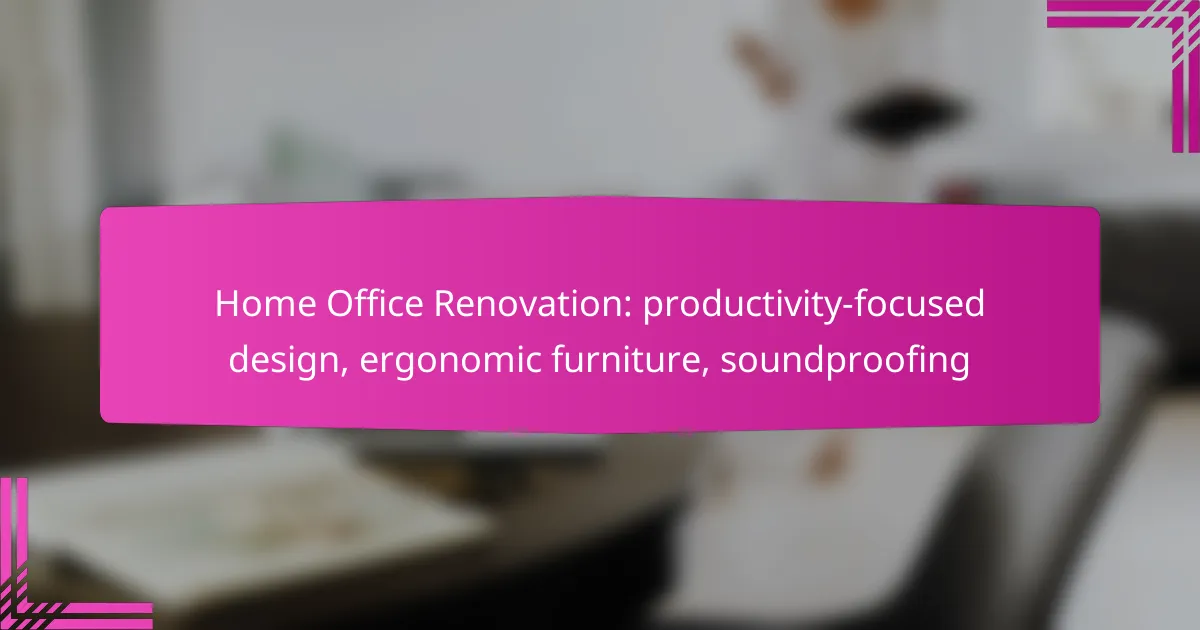Transforming your home office can greatly boost productivity by fostering a focused and efficient workspace. By integrating ergonomic furniture and soundproofing techniques, you can create an environment that minimizes distractions and enhances comfort, ultimately leading to improved work performance.
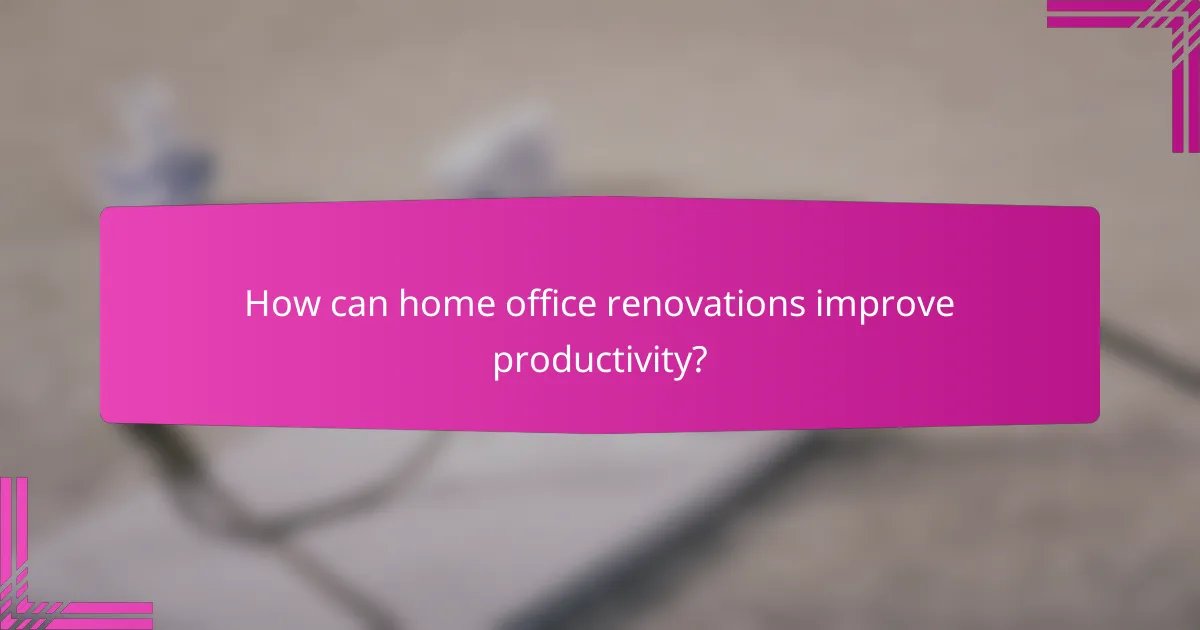
How can home office renovations improve productivity?
Home office renovations can significantly enhance productivity by creating an environment tailored for focus and efficiency. By incorporating ergonomic furniture, soundproofing, and dedicated workspaces, individuals can minimize distractions and improve their overall work performance.
Increased focus with dedicated workspaces
Creating a dedicated workspace is crucial for enhancing focus. A specific area designated for work helps signal to your brain that it’s time to concentrate, reducing the likelihood of distractions from home life. Ideally, this space should be separate from areas associated with relaxation or leisure.
Consider using room dividers or furniture arrangements that clearly delineate your work area. For instance, a small desk in a quiet corner or a converted spare room can serve as an effective workspace. Ensure that this area has adequate lighting and is free from clutter to further boost concentration.
Enhanced organization through design
Effective design plays a key role in improving organization within a home office. Thoughtful layouts and storage solutions can streamline workflows and keep essential items within easy reach. For example, using shelves, filing cabinets, or drawer organizers can help maintain order and reduce time spent searching for materials.
Incorporating technology, such as cable management systems and multi-functional furniture, can also enhance organization. Aim for a setup that promotes efficiency; for instance, consider a desk with built-in storage or a wall-mounted organizer for frequently used tools. This not only keeps the space tidy but also fosters a more productive work environment.
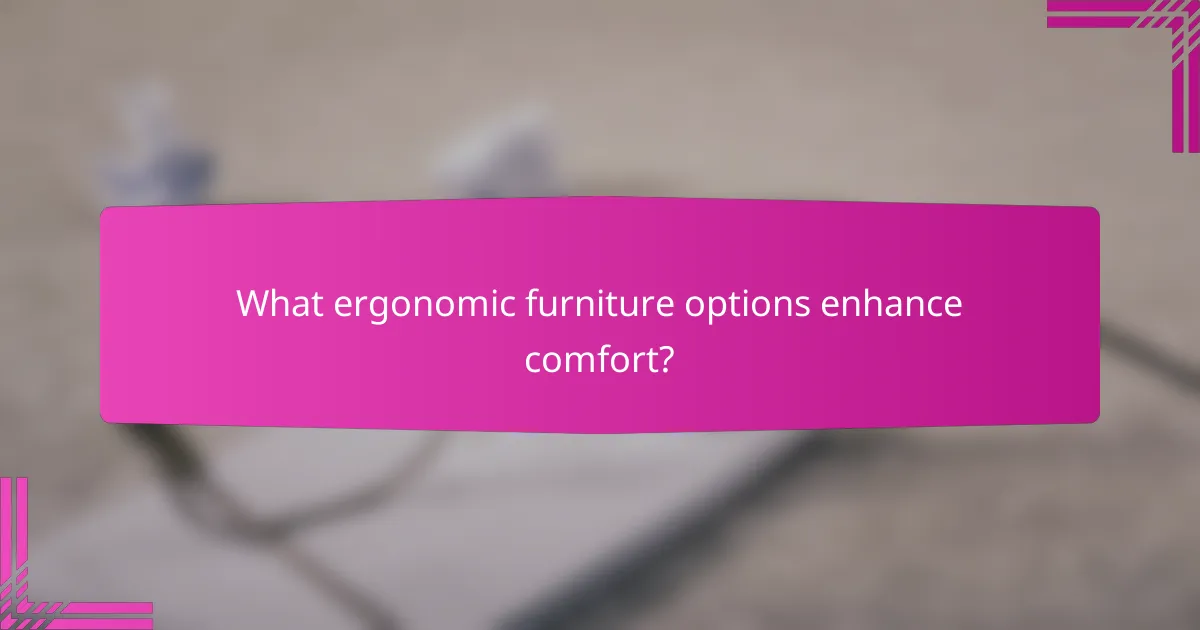
What ergonomic furniture options enhance comfort?
Ergonomic furniture options significantly enhance comfort by promoting better posture and reducing strain during long working hours. Key pieces include adjustable chairs and desks that cater to individual body types and preferences.
Herman Miller Aeron chair benefits
The Herman Miller Aeron chair is renowned for its ergonomic design, which supports the natural curvature of the spine. Its adjustable features allow users to customize seat height, armrest position, and lumbar support, making it suitable for various body shapes.
Investing in an Aeron chair can lead to increased productivity by minimizing discomfort and fatigue. Users often report improved focus and stamina during extended work sessions, making it a valuable addition to any home office.
Standing desks from Uplift Desk
Uplift Desk offers a range of standing desks that promote movement and flexibility throughout the workday. These desks can be easily adjusted to different heights, allowing users to switch between sitting and standing positions, which can help reduce the risks associated with prolonged sitting.
When choosing a standing desk, consider features such as stability, ease of adjustment, and surface area. Many models come with programmable height settings, enabling quick transitions between positions, which can enhance overall comfort and productivity.

How can soundproofing techniques enhance work quality?
Soundproofing techniques can significantly enhance work quality by minimizing distractions from external noise, allowing for better focus and productivity. Implementing effective soundproofing solutions creates a more conducive work environment, which can lead to improved concentration and overall job satisfaction.
Acoustic panels for noise reduction
Acoustic panels are designed to absorb sound waves, reducing echo and background noise in your home office. These panels can be mounted on walls or ceilings and are available in various materials, such as foam or fabric-covered options, which can blend with your decor.
When selecting acoustic panels, consider the size of your office and the level of noise you experience. For optimal results, aim for coverage that accounts for at least 20-30% of the wall space. This will help create a quieter atmosphere conducive to focused work.
Soundproofing curtains for home offices
Soundproofing curtains are heavy, dense fabrics that can block outside noise while also providing insulation. These curtains are particularly useful for windows that face busy streets or noisy environments, as they can significantly reduce sound transmission.
When choosing soundproofing curtains, look for options labeled as “acoustic” or “sound-blocking” to ensure effectiveness. Ensure the curtains extend beyond the window frame to minimize gaps where sound can enter. Pairing these curtains with blinds can further enhance soundproofing and light control in your workspace.

What are the essential design elements for a productive home office?
Key design elements for a productive home office include optimal lighting, effective color choices, ergonomic furniture, and soundproofing. These factors significantly influence focus, comfort, and overall efficiency in a workspace.
Optimal lighting solutions
Effective lighting is crucial for reducing eye strain and enhancing productivity. Aim for a combination of natural light and adjustable artificial lighting to create a well-lit environment. Position your desk near windows to take advantage of daylight, and use task lighting for focused work areas.
Consider using LED bulbs with a color temperature of around 4000K to 5000K, which mimics daylight and promotes alertness. Avoid harsh fluorescent lights that can cause fatigue and discomfort.
Color psychology in workspace design
The colors in your home office can significantly impact your mood and productivity. For instance, blue hues are known to enhance focus and calmness, while yellow can stimulate creativity. Choose a color palette that aligns with your work style and tasks.
Incorporate accent colors through decor or furniture to create an inspiring atmosphere. However, avoid overly bright or distracting colors that may lead to fatigue or loss of concentration. Aim for a balanced mix that fosters a productive environment.
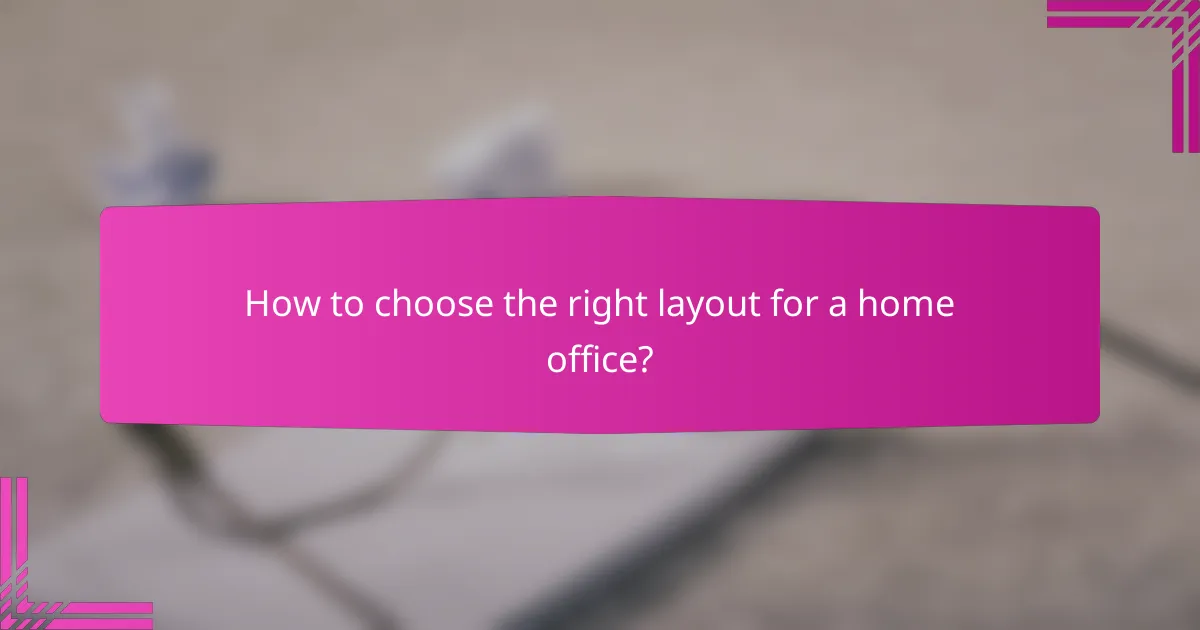
How to choose the right layout for a home office?
Choosing the right layout for a home office is crucial for enhancing productivity and comfort. Consider factors such as available space, work style, and the need for privacy or collaboration when selecting your office design.
Open vs. closed layouts
Open layouts promote collaboration and flexibility, making them ideal for those who frequently engage in discussions or teamwork. However, they can also lead to distractions from noise and movement.
Closed layouts offer privacy and reduced distractions, which can enhance focus and concentration. This setup is beneficial for tasks requiring deep thinking or confidentiality, but it may limit interaction with others.
Space-saving furniture arrangements
Utilizing space-saving furniture can maximize the functionality of a home office, especially in smaller areas. Consider multi-functional pieces like desks with built-in storage or foldable tables that can be stowed away when not in use.
Arranging furniture to create distinct zones can also improve workflow. For example, position your desk near natural light while keeping storage and equipment within easy reach. Avoid clutter by using vertical storage solutions, such as shelves or wall-mounted organizers.
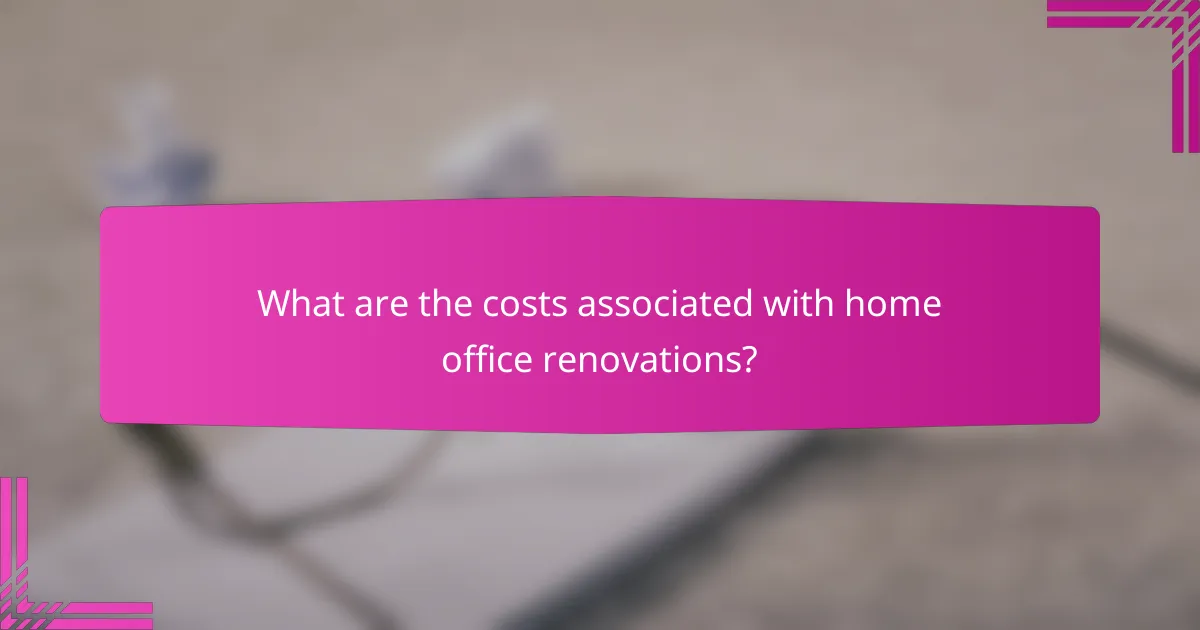
What are the costs associated with home office renovations?
The costs of home office renovations can vary widely based on the scope of the project, materials used, and the specific design choices made. On average, homeowners can expect to spend anywhere from a few hundred to several thousand dollars, depending on factors like furniture, soundproofing, and overall layout changes.
Budgeting for ergonomic furniture
When budgeting for ergonomic furniture, consider investing in items that promote comfort and productivity. Ergonomic chairs typically range from $200 to $1,500, while desks can cost between $300 and $2,000, depending on features like height adjustment and materials.
To maximize your budget, prioritize essential items such as a quality chair and desk. Look for sales or second-hand options to save costs, but ensure that the furniture meets ergonomic standards to avoid health issues in the long run.
Cost of soundproofing materials
Soundproofing materials can significantly impact the overall cost of your home office renovation. Basic soundproofing solutions, such as acoustic panels, can range from $20 to $100 per panel, while more comprehensive options like soundproof drywall may cost between $1.50 to $3 per square foot.
When selecting soundproofing materials, consider both effectiveness and budget. Combining different methods, such as using rugs, curtains, and wall panels, can provide a balanced approach to noise reduction without overspending. Always compare prices and look for bulk purchase discounts to optimize your investment.

What are the latest trends in home office design?
Current trends in home office design focus on enhancing productivity through ergonomic furniture, soundproofing, and biophilic elements. These features create a comfortable and efficient workspace that caters to the needs of remote workers.
Biophilic design elements
Biophilic design incorporates natural elements into the workspace to boost well-being and productivity. This can include the use of plants, natural light, and materials that mimic nature, such as wood or stone.
To implement biophilic design, consider adding potted plants, using large windows for natural light, or incorporating nature-inspired artwork. These elements can help reduce stress and increase focus, making your home office a more pleasant environment.
Smart home technology integration
Integrating smart home technology into your office can enhance efficiency and comfort. This includes smart lighting, automated temperature controls, and voice-activated assistants that streamline tasks and improve the overall work experience.
When selecting smart devices, prioritize those that can be easily controlled and customized to your preferences. For example, smart lighting can adjust based on the time of day, helping to maintain energy levels and focus throughout your work hours.

How can I future-proof my home office?
To future-proof your home office, focus on creating a versatile space that can adapt to changing work trends and personal needs. Incorporate ergonomic furniture, effective soundproofing, and flexible design elements to enhance productivity and comfort.
Adapting to remote work trends
Adapting your home office to remote work trends involves understanding the evolving nature of work environments and employee expectations. Consider integrating technology that supports virtual collaboration, such as high-quality video conferencing tools and reliable internet connectivity.
Design your space to accommodate various work styles, whether that means having a dedicated area for focused tasks or a collaborative zone for brainstorming sessions. Flexibility is key; modular furniture can easily be reconfigured to suit different activities.
Stay informed about emerging trends in remote work, such as hybrid models that combine in-office and remote work. This knowledge will help you make informed decisions about your office layout and technology investments, ensuring your space remains functional and relevant.
